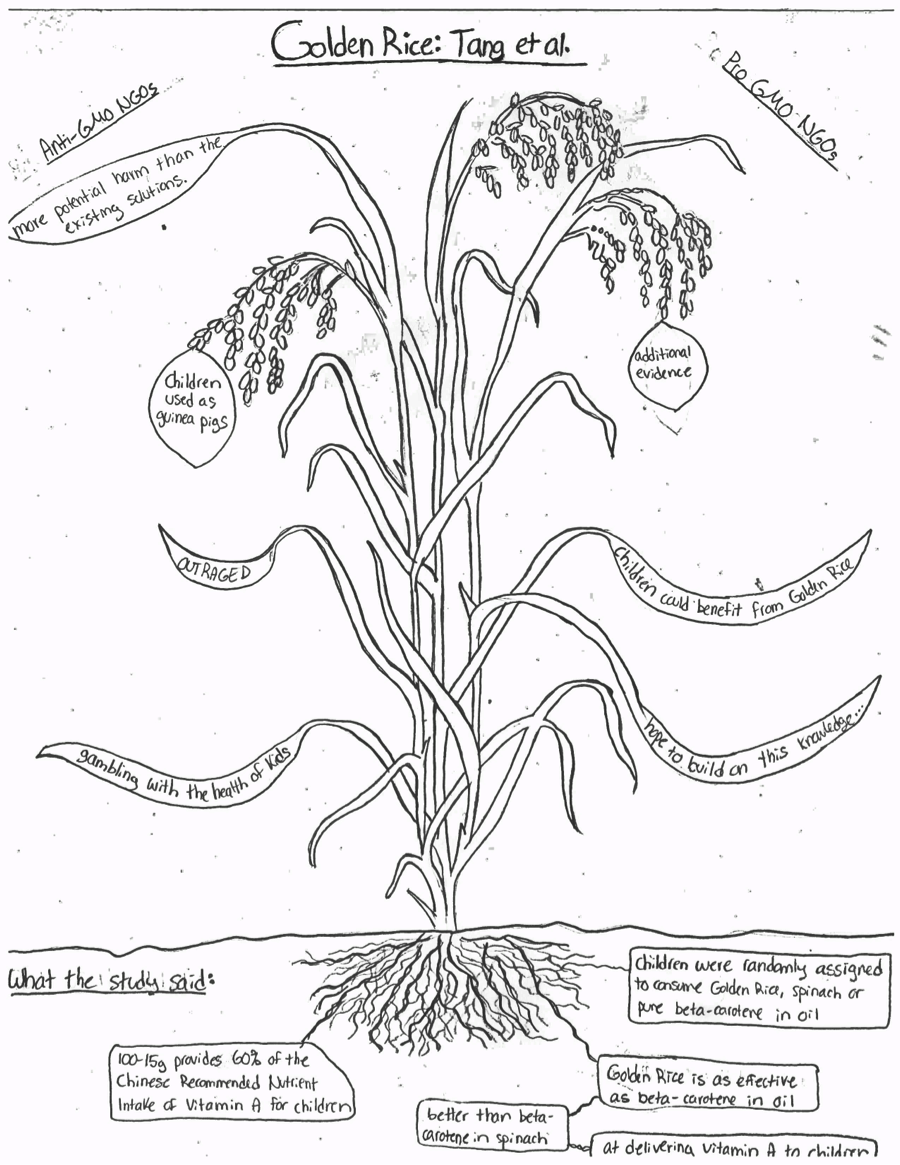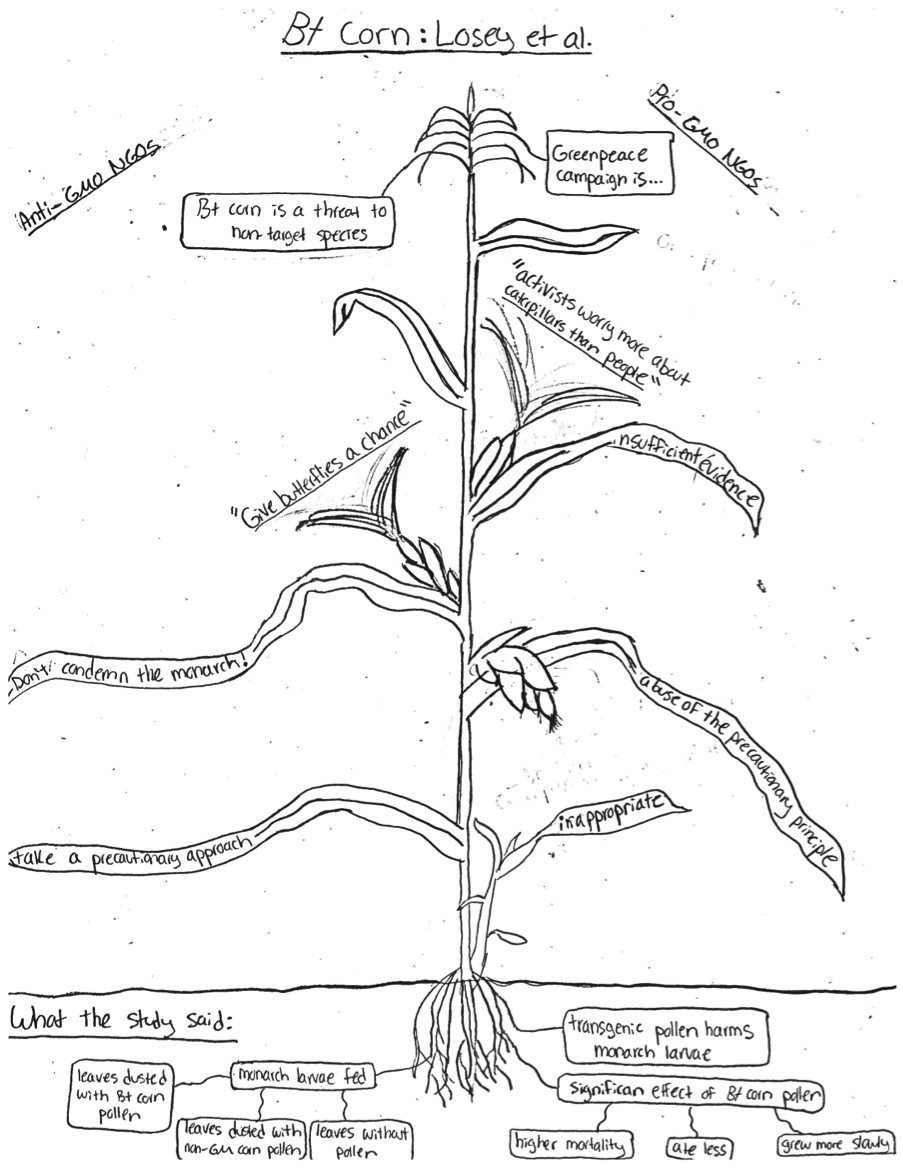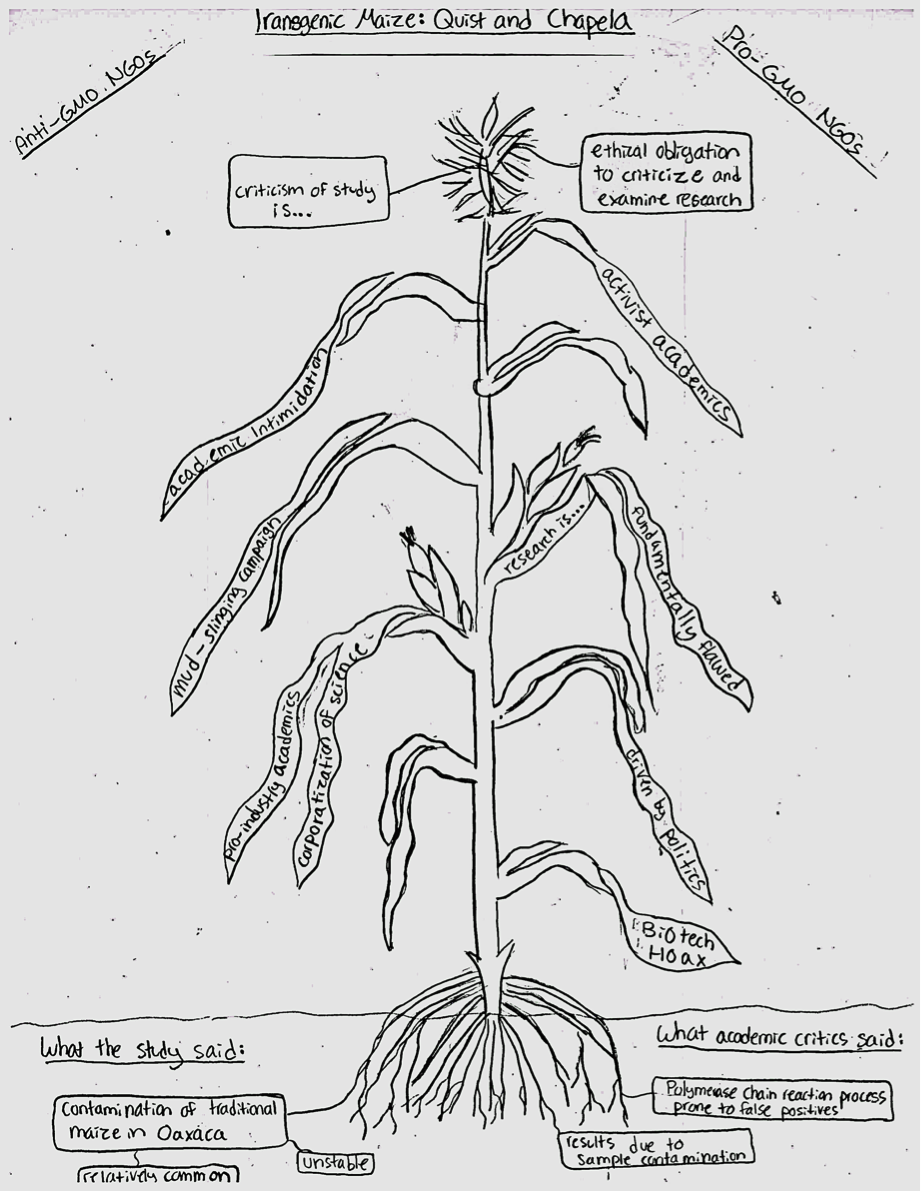Natalie Valentin
Positionality Statement:
I am a sophomore Environmental Policy major interested in community-based agriculture, natural resource management and the role of business in sustainable development. At Middlebury, I serve on the Food Committee of our Environmental Council and work as the Local Food Marketing Assistant for our Food and Dining service. I am the daughter of two engineers-turned-corporate executives and the sister of a biomedical engineer and a conservation biologist. As a dual France-US citizen, I have been heavily influenced by French food culture. I am also a locavore (meaning I only eat local or sustainably raised meat) and love to cook!
Situating Sound Silence: The Multiple Meanings and Roles of Science in Biotechnology Discourse
Situated knowledge is a fundamental concept of political ecology. It teaches us that all discourse is shaped by the positionality of those who produce it. Equally essential to the deconstruction of human-societal-environmental relations is recognizing and understanding the agency of non-human actors. In this paper, I aim to evoke these two key components of political ecology by tracing the discourses between pro- and anti-biotechnology NGOs for three scientific studies. I look at science as a non-human actor that shapes GMO discourse by summarizing the findings of these studies and then examining the rhetoric used by NGOs to respond to the findings. I aim to not only show how NGOs describe different scientific results but also to prompt the question, why do they respond as they do? I then reflect on the reciprocal manner in which the studies influence discourse as well as how discourse redefines the meaning and significance of science in the context of GMO debate. Accompanying visuals further demonstrate the growth of each discourse from the root results that sparked it to the ensuing responses that stem off of them.
Golden Rice: Evidence versus Ethics
Golden Rice is a rice variety genetically engineered to produce beta-carotene, which is convert to vitamin A in the body. The technology was developed as a possible way to alleviate blindness and malnutrition in poor populations (“Golden Rice Is Part of the Solution”). In April 2010, the American Journal of Clinical Nutrition published a study by Tufts researchers that showed that a bowl of 100-150g of cooked Golden Rice provides about 60% of the Chinese Recommended Nutrient Intake of Vitamin A for 6-8 year-old children (Tang et al. 2012).[1] It concluded that the beta-carotene in Golden Rice is as effective as pure beta-carotene in oil, and more effective than the beta-carotene in spinach, at providing vitamin A to children (Tang et al. 2012).
Golden Rice supporters met the study with excitement and embraced it as evidence of the technology’s potential. For example, the International Rice Research Institute (IRRI), a non-profit helping to develop Golden Rice, cites the study on their website as proof that malnourished children could benefit from Golden Rice as steady dietary supplement and cited its desire to build upon this “additional evidence” from “prestigious institutions (“Golden Rice in the News”). The Golden Rice Project touts the results as evidence that Golden Rice is “more than capable” of delivering beta-carotene to target populations and uses it to further the argument that Golden Rice has positive potential as a pro-poor technology (“Testing the Performance of Golden Rice”). Skeptics of the technology, however, were not equally enamored.
To date, Golden Rice has not undergone animal testing; consequently, when Greenpeace East Asia discovered that the children in the study were not explicitly informed that the rice they were eating was GM, they informed Chinese regulation officials, launched a fierce online campaign condemning the “smoke and mirrors” study and accused the researchers of “gambling with the health of 24 kids” by using them as “guinea pigs”(Tan 2012). The study furthered rhetoric of “bug business hustling” and irresponsible biotechnologists willing to skirt regulation in order to further their products (Tan 2012) (“Golden Illusion). Though biotechnology has traditionally held strong governmental support in China, the Greenpeace campaign sparked a media and public outcry against GMOs and biotech research (Whitehead 2012). Their activism resulted in a three-month investigation that culminated in the firing of two officials from the Chinese Center for Disease Control and Prevention as well as the head of science and technology at the Zhejiang Academy of Medical Sciences.
The discourse that emerged from this study demonstrates that science can be interpreted based on results or based on methodology. Whereas Golden Rice proponents focused on the study’s results, the opposition denounced the manner in which it was conducted. The discourse of both sides focused on details of the study itself as well its implications; however, one used the study as empirical evidence while the other used it as fodder for rhetoric.
Figure 1: The roots of this example are the findings of Tang et. Al, 2012. The ensuing discourse that grew out of these findings is summarized by the quotations in the leaves.
Bt Corn and Monarch Butterflies: Precaution or Paranoia?
Bt corn has been genetically engineered to express a toxin from the bacterium Bacillus thuringiensis that is poisonous to insect pests such as corn borer. In May of 1999, Nature published a study that examined the possible effects of wind-blown Bt corn pollen on species other than the intended pests, known as non-target organisms (Losey 1999). The authors found that monarch butterfly larvae fed milkweed leaves dusted with pollen from Bt corn “ate less, grew more slowly and suffered higher mortality” than those reared on leaves dusted with non-GM corn pollen or on leaves without pollen (Losey 1999).
The study prompted immediate activism from Greenpeace. The following June, activists dressed as butterflies successfully picketed a European Union meeting of environmental ministers toting a banner that read, “Give butterflies a chance” (Belt 2003). Soon thereafter, Greenpeace New Zealand called upon the Environmental Risk Management Authority to take a precautionary approach and reject the application of international seed company Pioneer to perform field trials of Bt corn in the country until it was proven that the technology had no harmful environmental or health effects (“Don’t Condemn the Monarch Butterfly”).
In response to the Greenpeace campaign, the Institute of Public Affairs, an Australian non-profit think tank, cited head researcher Losey’s warning that drawing conclusions based solely on the study’s initial laboratory results would be “inappropriate” (Kellow 1999). It criticized the activism for being insufficiently supported and therefore an abuse of the precautionary principle (Kellow 1999). The Center for Global Food Issues went after the activists themselves, characterizing them as privileged Westerners who “worry more about 14 captive Monarch caterpillars than about higher crop yields able to feed the planet’s 800 million still-malnourished people” (“March of Progress.” Avery 2002).
This example demonstrates how science can both directly and indirectly influence biotechnology discourse. Greenpeace based its discourse and monarch conservation campaign directly on the study’s results. In contrast, the discourse of pro-biotechnology NGOs was shaped primarily by the fact that Greenpeace based its activism on a single study, rather than by a conflict with the study itself. It is clear from the preceding two examples that neither the pro- nor anti-GMO camp consistently has the science on their side and that those stuck on the defensive often turn to critiques of methodology to discredit their opponents.
Figure 2: The roots of the monarch butterfly discourse are the findings of Losey’s study. The discourse that grew out of these findings is summarized by the quotations in the leaves.
Maize Contamination: Inaccuracy, Integrity, and Intimidation
In November 2001, Nature published an article from University of California Berkeley that reported the contamination of traditional maize varieties in Oaxaca, Mexico by US-grown transgenic corn (Quist and Chapela 2001). The authors concluded that contamination events were relatively common and that the GM DNA appeared to be randomly fragmented in the genome (Quist and Chapela 2001). These results were predictably controversial as they suggested that transgenic maize had found its way into Mexico despite the country’s moratorium on US GM corn imports at the time and that the resulting contamination was unstable. The study quickly came under scrutiny by scientists who criticized its use of polymerase chain reaction (PCR), a process notorious for generating false-positives, and chalked up its results to sample contamination (Klapinsky et al. 2001) (Christou 2002).
In response to the criticism, the Organic Consumers Association claimed that the attacks were due to “the corporate alliance between Berkeley and [seed company] Novartis” (Rowell 2009). The Institute for Food and Development Policy (Food First) issued a Joint Statement in defense of the researchers signed by 144 civil society and farmer organizations that accused “pro-industry” scientists of engaging in “academic intimidation” and “a highly unethical mud-slinging campaign” (Manoochehri 2002). Recently, the Union of Concerned Scientists cited the discovery that two authors who had sent the editors of Nature letters disparaging the study had been linked to The Bivings Group, an online communications and public relations firm with ties to Monsanto, as evidence that the debate was due to the corporatization of science (Grifo et al. 2012).
The pro-biotechnology AgBioWorld foundation retaliated to these actions with its own joint statement in which it argued that scientists have an “ethical obligation to rigorously examine the results and methodology of reported research” and suggested that Quist and Chapela’s conclusions had been “driven by politics or activism, rather than science” (Prakash 2002). The director of global food issues for the Hudson Institute called the study “merely the latest in a series of biotech hoaxes” and invoked “respected scientific journals like Nature [to] not succumb to the political passions of the moment” by publishing “fundamentally flawed” research (Avery 2002).
The polarizing discourse that emerged from this study is particularly interesting because while both GM proponents and opponents accuse each other of bias, they agree that it is likely and/or inevitable that contamination will eventually occur (Prakash 2002) (Manoochehri 2002). This concession demonstrates that the debate between NGOs is not about the results of the study at all; rather, it is about scientific integrity. This example questions the meaning of science as an impartial source of information, demonstrates the difficulty of defining “sound science,” prompts a more nuanced perception of scientific objectivity, and opens up a discussion of the importance of integrity in scientific research.
Figure 3: The roots of the Mexican transgenic contamination discourse are the findings of Quist and Chapela. The polarizing rhetoric that grew out of these findings is represented by the leaves.
Conclusions
The three examples of Tang et al. 2012, Losey et al. 1999, and Quist and Chapela 2001, demonstrate the various ways that science shapes, and is shaped by, GMO discourse. It can reinforce arguments or provoke debates over ethics and the corporatization of science. It can motivate activism, justify precaution or act as fuel for fiery rhetoric. At times it is characterized as neutral and valued empirically; at others, it is portrayed as deeply political.
The multiple roles and meanings of science in biotechnology discourse reveal the interplay between situated knowledge and the agency of non-human actors. Just as individuals or groups have positionality, so does science. The backgrounds and connections of the researchers that conduct it, the controversies surrounding the technologies it studies, the implications of its results and the social, political and historical context in which it exists all contribute to the role that science plays in any given discourse. Perhaps the best way to understand science through the lens of political ecology, then, is to revision it as a socially constructed discourse in and of itself—to borrow a term from feminist scholar Donna Haraway, as a “coding trickster which whom we must learn to converse” (Haraway 1988).
Annotated Bibliography
Belt, Helk Van Den. 2003. “Debating the Precautionary Principle: ‘Guilty until Proven Innocent’ or ‘Innocent until Proven Guilty’?” Plant Physiology. 132(3): 1122–1126.
This article provided a well-cited and comprehensive overview of the monarch butterfly controversy. I used it to find primary sources from NGOs on both sides of the debate and to gain a big-picture understanding of the debate’s trajectory. The overview is followed by a very interesting, though opinionated, investigation of the use of the precautionary principle in environmental discourse.
Haraway, Donna. 1988. “Situated Knowledges: The Science Question in Feminism and the Privilege of Partial Perspective.” Feminist Studies. 14:3 pp. 575-599
This article initially inspired me to re-think the meanings and roles of science through the lens of situated knowledge. It served as a reference and a theoretical guide for my personal thinking and understanding as I pieced together the complex discourses surrounding the three studies.
Losey, J.E., Rayor, L.S., and Carter, M.E. 1999. “Transgenic pollen harms monarch larvae.” Nature 399:214
This study of the affects of Bt corn on monarch butterflies is at the center of the debate about the possible threats that transgenic crops pose a threat to non-target organisms. I chose the discourse surrounding this study in order to demonstrate how science directly and indirectly shapes discourse.
Quist, D. and I. Chapela. 2001.“Transgenic DNA introgressed into traditional maize landraces in Oaxaca, Mexico” Nature 414: 541-543.
This study sparked a fierce and polarizing debate about the potential ecological risks of GM crops. I chose to research the discourse surrounding it because it raises questions about objectivity in science, knowledge production, the politicization of research, and the interactions between academia, NGOs and industry.
Rowell, Andy. 2009. “Mexico Corn Contamination: How Monsanto & University of California Tried to Silence Dr. Ignacio Chapela.” Organic Consumers Association. http://www.organicconsumers.org/articles/article_17843.cfm
This article presents a detailed, in-depth investigation into the controversy surrounding the Quist and Chapela study. Although it was written by an activist for GM Watch and published on the website of an anti-GMO organization, I did my best to look through the positionality and used it to piece together the evolution of the debate and to find primary sources.
Tang G, Hu Y, Yin S, Wang Y, Dallal GE, Grusak MA & Russell RM. 2012. “β-carotene in Golden Rice is as good as β-carotene in oil at providing vitamin A to children.“ American Journal of Clinical Nutrition 96: 658-664.
The results of this study suggest that Golden Rice can be an effective vitamin A supplement for children. While its results are generally accepted as valid, its methodology has come under scrutiny. It provides a great example of how science can be used both empirically and rhetorically. It prompted me to ask the question; in scientific inquiry, can the means discredit the ends?
Full Biography
Avery, D. T. 2002 “British Science Journal Admits Publishing Phony Report” The Hudson Institute. http://www.hudson.org/index.cfm?fuseaction=publication_details&id=1466
Avery, D.T. 2002. “The March of Progress.” Center for Global Food Issues. http://www.cgfi.org/2002/04/the-march-of-progress/
Belt, Helk Van Den. 2003. “Debating the Precautionary Principle: ‘Guilty until Proven Innocent’ or ‘Innocent until Proven Guilty’?” Plant Physiology. 132(3): 1122–1126.
Christou, P. 2002. “No Credible Scientific Evidence is Presented to Support Claims that Transgenic DNA was Introgressed into Traditional Maize Landraces in Oaxaca, Mexico.” Transgenic Research 11: iii–v.
“Don’t Condemn the Monarch Butterfly: Greenpeace calls on ERMA to turn down application for Genetically Engineered Bt Maize.” 1999. Greenpeace. http://www.greenpeace.org/new-zealand/en/press/don-t-condemn-the-monarch-butt/
“Golden Illusion: the broken promises of ‘golden’ rice.” 2012. Greenpeace International. http://www.greenpeace.org/seasia/ph/PageFiles/462570/Golden%20Illusion.pdf
“Golden Rice Is Part of the Solution.” Golden Rice Project. http://www.goldenrice.org/index.php. Accessed June 19, 2013.
“Golden Rice in the news.” 2012. Golden Rice Blog. International Rice Research Institute. http://www.irri.org/index.php?option=com_k2&view=item&id=12327:golden-rice-in-the-news&lang=en
Grifo, F., Halpern, M., and Hansel, P. 2012. “Heads They Win, Tails We Lose: How Corporations Corrupt Science at the Public’s Expense.” The Scientific Integrity Program of the Union of Concerned Scientists. pp. 19
Haraway, Donna. 1988. “Situated Knowledges: The Science Question in Feminism and the Privilege of Partial Perspective.” Feminist Studies. 14:3 pp. 575-599
Kaplinsky, N., D. Braun, D. Lisch, A. Hay, S. Hake, M. Freeling. 2002. “Maize transgene results in Mexico are artefacts” Nature 416: 601.
Kellow, Ansely. 1999. “The Flap over Butterflies.” Review. Institute of Public Affairs. pp.17
Losey, J.E., Rayor, L.S., and Carter, M.E. 1999. “Transgenic pollen harms monarch larvae.” Nature 399:214
Manoochehri, Michael. 2002. “Joint Statement on the Mexican GM Maize Scandal.” Food First. http://www.foodfirst.org/en/node/198
Prakash, C.S. 2002. “Joint Statement in Support of Scientific Discourse in Mexican GM Maize Scandal” AgBioWorld. http://www.agbioworld.org/jointstatement.html
Quist, D. and I. Chapela. 2001.“Transgenic DNA introgressed into traditional maize landraces in Oaxaca, Mexico” Nature 414: pp. 541-543
Rowell, Andy. 2009. “Mexico Corn Contamination: How Monsanto & University of California Tried to Silence Dr. Ignacio Chapela.” Organic Consumers Association. http://www.organicconsumers.org/articles/article_17843.cfm
Tan, Monica. 2012. “24 children used as guinea pigs in genetically engineered ‘Golden Rice’ trial” Greenpeace East Asia. http://www.greenpeace.org/eastasia/news/blog/24-children-used-as-guinea-pigs-in-geneticall/blog/41956/
“Testing the Performance of Golden Rice.” Golden Rice Project. http://www.goldenrice.org/Content2-How/how8_tests.php. Accessed June 20, 2013
Whitehead, RJ. 2012. “Greenpeace Gone Too Far with GM Golden Rice Scandal.” Food Navigator Asia. http://www.foodnavigator-asia.com/Policy/Greenpeace-gone-too-far-with-GM-Golden-Rice-scandal . Accessed June 20, 2012.
[1] 100-150g of cooked rice is about 50g dry weight. The average serving size of rice is 75g dry weight.



